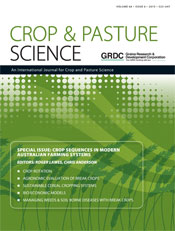
Crop and Pasture Science
Volume 66 Number 6 2015
Crop Sequences in Modern Australian Farming Systems
CP14252Break crops and rotations for wheat
Based on a meta-analysis of >900 comparisons, we found that wheat growing after break crops exceeds the yield after wheat. The mean additional yield varied from 0.5 t ha–1 after oats, to 0.8 t ha–1 after temperate oilseeds and 1.2 t ha–1 after temperate grain legumes, and was generally not proportional to yield of wheat after wheat. Mechanisms by which break crop affect yield were reduced root disease, more residual water and nitrogen, better weed control, H2 fertilisation by legumes and possible effects on mycorrhizae.
CP14136Long-term cropping system studies support intensive and responsive cropping systems in the low-rainfall Australian Mallee
Continuous-cropping systems based on no-till and crop residue retention have been adopted widely in low-rainfall regions of Southern Australia in response to the low productivity and unsustainable practices of the traditional rotations. Long-term field trials showed that continuous cropping can be profitable where water-use efficiency was increased, and that in a run of drought years, this occurred on the light-textured soils. Managing climatic risk and deciding when break crops can be effectively sequenced to manage weeds, nutrition issues or disease remains a challenge to sustaining continuous-cropping systems.
CP14166Break-crop effects on wheat production across soils and seasons in a semi-arid environment
Consistent with work in higher rainfall environments, the inclusion of breaks appears to have a fixed effect on subsequent cereal yield. Three years after incorporation of a break there were cumulative benefits of ~1 t ha–1 in wheat yield compared with continuous cereal. Breaks were found to enhance nitrogen cycling and supply in subsequent cereal crops, and this is considered a key driver of the beneficial break effect.
CP14262Crop-sequence effects on productivity in a wheat-based cropping system at Wongan Hills, Western Australia
Wheat yield responded positively when grown after fallow, oats cut for hay, volunteer pasture, lupins, and serradella pasture compared to wheat, but not after barley or canola, in a four-year experiment at Wongan Hills, Western Australia. Effects were mediated by differences in soil water, soil nitrogen, and annual ryegrass population. Effects mediated by soil water and soil nitrogen lasted at most two years, but the weed population effects were still strong three years after the treatment crops.
CP14097Dynamic crop sequencing in Western Australian cropping systems
The study demonstrated the benefits of break crops in a wheat-based system. Crops yielded more when grown on residues other than their own and often experienced significant yield penalties when grown on their own residues or on residues of similar crop types. Wheat treated with fluquinconazole seed dressing consistently produced significantly higher yields than untreated wheat. The subsoil N fertility and grain yield of wheat treatments were markedly improved following lupins and the effect lasted for at least 2 years.
CP14135Considering long-term ecological effects on future land-use options when making tactical break-crop decisions in cropping systems
The Land Use Sequence Optimiser (LUSO) framework was adapted to enable it to analyse immediate tactical decisions regarding break crops and sequencing, while accounting for both short- and long-term implications. The revised framework was applied to two example scenarios to demonstrate how it can be used for simple decision-support, as well as more in-depth analysis and insight into the factors influencing the immediate decision.
CP14185Gaining insight into the risks, returns and value of perfect knowledge for crop sequences by comparing optimal sequences with those proposed by agronomists
Here we value the profitability and risk of crop sequences over a 10 year time frame in a semi-arid farming region in Australia, where optimal crop sequences are compared to those chosen by local agronomists. The optimal crop sequence suggested farmers grow two break crops or pastures in succession to manage severe weed and disease problem, while agronomists tended to recommend a similar number of break crops and pastures, but grow them at regular intervals. The value of a particular crop sequence relative to another is dependent on the level of biotic stress present, while the risk of a particular crop and the risk of a crop sequence over 10 years are often unrelated.
CP14221Crop sequences in Western Australia: what are they and are they sustainable? Findings of a four-year survey
A survey was conducted of commercial broadacre paddocks in the south-west cropping zone of Western Australia from 2010 to 2013. Cropping of wheat, canola, barley and lupin accounted for 85% of land use. Weed density, soilborne pathogens and soil N were maintained at levels suitable for wheat production. However, changes in land use over the past decade to less legume and more oilseed crops are likely to alter soilborne pathogen and nitrogen/carbon dynamics in the longer term.
CP14221 Abstract | CP14221 Full Text | CP14221PDF (413 KB) Open Access Article



